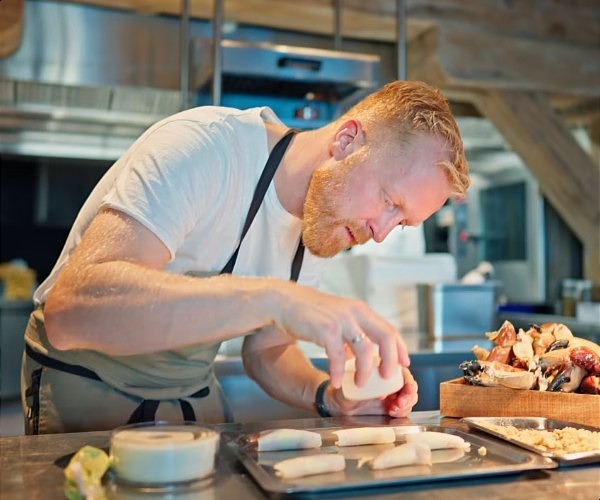Four towns, five attractions, in the part of Jutland known as The Triangle – and all close to each other. These special sites each have something different to offer their visitors but they are all interesting, informative and interactive.
Most visitors to Denmark pass through this area which is dissected by a main road across the country. They are missing out on five treats – the Lego House in Billund, a bridge walk over Lillebælt, a Viking settlement in Jelling, a Medieval castle in Kolding and Trapholt, also in Kolding – plus an opportunity for a luxurious stay in Haraldskær, an old manor house.

The Lego House in Billund
Billund is the home of Lego and celebrates the success of these interlocking plastic bricks with a Lego House that attracts visitors from all over the world. This unusual building dominates the centre of the town of Billund. Flights of steps, front and back lead to play spaces and viewing platforms incorporated in the roof and are open day and night.

Four floors and a basement which relates the history of Lego display incredible creations ranging from huge dinosaurs and urban landscapes to delicate floral creations. Some of these creations are displayed on the leaves of a large tree that rises from floor to ceiling. Large activity areas prove irresistible to people of all ages who soon become engrossed in their own creations.
Everything you need to plan your trip in 2024

A short walk from the Lego House is Legoland, a theme park based on the famous product and littered with interesting installations. An elevated mono-rail above the park and small boats on its lake offer different perspectives on re-creations of famous buildings, and popular cities. Legoland and the more popular Lego House are not just for children but will entertain visitors of all ages.

A bridge walk on the Old Lillebælt Bridge
Little Belt or Lillebælt is a straight between mainland Denmark and Funen Island. In 1935 the first bridge to span this straight, a road and railway bridge was constructed. A second bridge was built in 1970 and the original bridge became known as the Old Lillebælt Bridge. Visitors can now don dungarees and clip themselves to a rail in order to climb to the highest level and walk across this bridge. It is a thrilling experience and very safe. An accompanying guide will point out landmarks and take photos – cameras and mobile phones are not allowed. The views are stunning and the regular rumbling of trains passing below enhance the exhilaration of this experience.

Home of the Viking kings in Jelling
During the tenth century a rune stone was placed in Jelling bearing the name Denmark by King Harald Bluetooth. A name since adopted by modern technology. On this stone, displayed outside the church, King Harald credits himself with having conquered Norway and brought Christianity to Denmark. He also organised the construction of two barrows and church in the same place. These monuments, the Jelling Monuments, are the best Viking monuments in Europe. In 1994 they became a designated UNESCO World Heritage. The addition of a visitor and experience centre, Kongernes Jelling, has created a fascinating insight into an ancient royal house credited with the creation of Denmark. A walk around Kongernes sets the scene for exploring the site itself. This excellent centre offers plenty of opportunities to interact with the unusual and informative displays introducing visitors to the Viking way of life.

During the tenth century a rune stone was placed in Jelling bearing the name Denmark by King Harald Bluetooth. A name since adopted by modern technology. On this stone, displayed outside the church, King Harald credits himself with having conquered Norway and brought Christianity to Denmark. He also organised the construction of two barrows and church in the same place. These monuments, the Jelling Monuments, are the best Viking monuments in Europe. In 1994 they became a designated UNESCO World Heritage. The addition of a visitor and experience centre, Kongernes Jelling, has created a fascinating insight into an ancient royal house credited with the creation of Denmark. A walk around Kongernes sets the scene for exploring the site itself. This excellent centre offers plenty of opportunities to interact with the unusual and informative displays introducing visitors to the Viking way of life.

Medieval castle ruins in Kolding
For adult visitors to Koldinghus the medieval castle in Kolding, the most fascinating aspect is the sensitive restoration. An old ruin has been turned into a journey through the history of what was once the most important castle in Denmark. It is part of the Royal Danish Collection which includes two other Danish castles – Rosenborg and Amalienborg, both in Copenhagen. Walkways allow visitors to appreciate this extraordinary restoration whereby pillars support the roof and everything else hangs from the roof to avoid putting pressure on the ancient walls. This ancient castle has been brought to life again.

An important part of this museum is the permanent display of Flora Danica in the Library Hall. This is the first public exhibition of the original luxurious porcelain dinnerware which is still used in the Royal House on very special occasions. It is named Flora Danica after a project of the same name to create a reference to all wild plants. Around 1789 it was decided to record thousands of plants with names and descriptions onto this porcelain dinnerware. Elsewhere in the castle there are temporary exhibitions and several workshops where visitors can interact with history and dress appropriately – an activity particularly appealing to children visiting the castle.

Trapholt in Kolding
Kolding is also home to Trapholt, a museum that defies description it is so unusual. The official, shortened, name is a “museum for modern painting, crafts, design, and furniture design”. This museum which was opened in 1988 occupies an old apple farm overlooking Kolding Fjord. It is surrounded by a sculpture park displaying works by contemporary Danish artists. The original owner of the land, a dentist, did not have any children so he decided to give the land to town on the condition that it would be used as an art museum. The museum has three areas with different exhibitions accessed from the main street that runs through the building. At Trapholt visitors can really appreciate the Danish flair for design relating to all aspects of homelife from coffee pots to chairs. A collection of around 600 chairs from the twentieth century features the work of some well-known designers including the prolific Nanna Ditzel and the visionary Arne Jacobsen who designed the egg chair. Café Gustav Lind is part of the Trapholt experience offering delicious organic food.

Stay at Haraldskær
Haraldskær in the little village of Skibet, is an old manor house with a history that stretches back for six hundred years. On the main road between Billund and Vejle it is ideally placed for a luxurious sojourn while exploring The Triangle in Jutland. Surrounded by the lush green countryside of the old estate it has been refurbished and modernised to create a luxury hotel and conference centre. Dinner here is a gastronomic delight whether partaken in the dining hall or vaulted cellar – a wine cellar that stores hundreds of top-quality European wines. The menu is based on seasonal, local organic food as far as possible and, in the interests of sustainability avoids waste and the expense of importing exotic food. So don’t ask for a banana at breakfast.

Did you enjoy this article?
Receive similar content direct to your inbox.
Please enable JavaScript in your browser to submit the form




